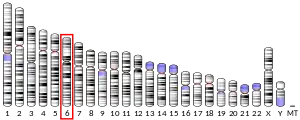HLA-DRB4
Major histocompatibility complex, class II, DR beta 4, also known as HLA-DRB4, is a human gene.[2]
| HLA-DRB4 | |||||||||||||||||||||||||
|---|---|---|---|---|---|---|---|---|---|---|---|---|---|---|---|---|---|---|---|---|---|---|---|---|---|
| Identifiers | |||||||||||||||||||||||||
| Aliases | HLA-DRB4, DR-4, DR4, DRB4, HLA-DR4B, major histocompatibility complex, class II, DR beta 4, HLA-DRB4* | ||||||||||||||||||||||||
| External IDs | GeneCards: HLA-DRB4 | ||||||||||||||||||||||||
| |||||||||||||||||||||||||
| Orthologs | |||||||||||||||||||||||||
| Species | Human | Mouse | |||||||||||||||||||||||
| Entrez |
| ||||||||||||||||||||||||
| Ensembl |
|
| |||||||||||||||||||||||
| UniProt |
| ||||||||||||||||||||||||
| RefSeq (mRNA) |
| ||||||||||||||||||||||||
| RefSeq (protein) |
| ||||||||||||||||||||||||
| Location (UCSC) | Chr 6: 32.54 – 32.56 Mb | n/a | |||||||||||||||||||||||
| PubMed search | [1] | n/a | |||||||||||||||||||||||
| Wikidata | |||||||||||||||||||||||||
| |||||||||||||||||||||||||
Function
The protein encoded by this gene belongs to the HLA class II beta chain paralogues. The class II molecule is a heterodimer consisting of an alpha (DRA) and a beta chain (DRB), both anchored in the membrane. It plays a central role in the immune system by presenting peptides derived from extracellular proteins. Class II molecules are expressed in antigen-presenting cells (APC: B lymphocytes, dendritic cells, macrophages).[2]
Gene structure and polymorphisms
The beta chain is approximately 26-28 kDa. It is encoded by 6 exons, exon one encodes the leader peptide, exons 2 and 3 encode the two extracellular domains, exon 4 encodes the transmembrane domain and exon 5 encodes the cytoplasmic tail. Within the DR molecule the beta chain contains all the polymorphisms specifying the peptide binding specificities. Hundreds of DRB1 alleles have been described and typing for these polymorphisms is routinely done for bone marrow and kidney transplantation.[2]
Gene expression
DRB1 is expressed at a level five times higher than its paralogues DRB3, DRB4 and DRB5. DRB1 is present in all individuals. Allelic variants of DRB1 are linked with either none or one of the genes DRB3, DRB4 and DRB5. There are 4 related pseudogenes: DRB2, DRB6, DRB7, DRB8 and DRB9.[2]
See also
References
- "Human PubMed Reference:". National Center for Biotechnology Information, U.S. National Library of Medicine.
- "Entrez Gene: HLA-DRB4 major histocompatibility complex, class II, DR beta 4".
Further reading
- Germain RN (1996). "Binding domain regulation of MHC class II molecule assembly, trafficking, fate, and function". Semin. Immunol. 7 (6): 361–72. doi:10.1006/smim.1995.0041. PMID 8775462.
- O'Brien RM, Cram DS, Russ GR, et al. (1992). "Nucleotide sequences of the HLA-DRw12 and DRw8 B1 chains from an Australian aborigine". Hum. Immunol. 34 (2): 147–51. doi:10.1016/0198-8859(92)90041-K. PMID 1358866.
- Kenter M, Otting N, Anholts J, et al. (1992). "Mhc-DRB diversity of the chimpanzee (Pan troglodytes)". Immunogenetics. 37 (1): 1–11. doi:10.1007/BF00223539. PMID 1428007. S2CID 26557301.
- Dong RP, Kimura A, Sasazuki T (1992). "Sequence analysis of three novel DRw14-DRB1 alleles". Immunogenetics. 36 (2): 130–3. doi:10.1007/BF00215291. PMID 1612646. S2CID 32928324.
- Piatier-Tonneau D, Gastinel LN, Amblard F, et al. (1991). "Interaction of CD4 with HLA class II antigens and HIV gp120". Immunogenetics. 34 (2): 121–8. doi:10.1007/BF00211424. PMID 1869305. S2CID 10116507.
- Nong Y, Kandil O, Tobin EH, et al. (1991). "The HIV core protein p24 inhibits interferon-gamma-induced increase of HLA-DR and cytochrome b heavy chain mRNA levels in the human monocyte-like cell line THP1". Cell. Immunol. 132 (1): 10–6. doi:10.1016/0008-8749(91)90002-S. PMID 1905983.
- Rosenstein Y, Burakoff SJ, Herrmann SH (1990). "HIV-gp120 can block CD4-class II MHC-mediated adhesion". J. Immunol. 144 (2): 526–31. PMID 1967269.
- Callahan KM, Fort MM, Obah EA, et al. (1990). "Genetic variability in HIV-1 gp120 affects interactions with HLA molecules and T cell receptor". J. Immunol. 144 (9): 3341–6. PMID 1970352.
- Bowman MR, MacFerrin KD, Schreiber SL, Burakoff SJ (1991). "Identification and structural analysis of residues in the V1 region of CD4 involved in interaction with human immunodeficiency virus envelope glycoprotein gp120 and class II major histocompatibility complex molecules". Proc. Natl. Acad. Sci. U.S.A. 87 (22): 9052–6. doi:10.1073/pnas.87.22.9052. PMC 55099. PMID 1978941.
- Gyllensten UB, Sundvall M, Erlich HA (1991). "Allelic diversity is generated by intraexon sequence exchange at the DRB1 locus of primates". Proc. Natl. Acad. Sci. U.S.A. 88 (9): 3686–90. Bibcode:1991PNAS...88.3686G. doi:10.1073/pnas.88.9.3686. PMC 51517. PMID 2023919.
- Lee KW, Johnson AH, Hurley CK (1990). "Two divergent routes of evolution gave rise to the DRw13 haplotypes". J. Immunol. 145 (9): 3119–25. PMID 2212675.
- Gorski J (1989). "First domain sequence of the HLA-DRB1 chain from two HLA-DRw14 homozygous typing cell lines: TEM (Dw9) and AMALA (Dw16)". Hum. Immunol. 24 (2): 145–9. doi:10.1016/0198-8859(89)90054-2. PMID 2466818.
- Fan WM, Kasahara M, Gutknecht J, et al. (1990). "Shared class II MHC polymorphisms between humans and chimpanzees". Hum. Immunol. 26 (2): 107–21. doi:10.1016/0198-8859(89)90096-7. PMID 2511168.
- Clayton LK, Sieh M, Pious DA, Reinherz EL (1989). "Identification of human CD4 residues affecting class II MHC versus HIV-1 gp120 binding". Nature. 339 (6225): 548–51. Bibcode:1989Natur.339..548C. doi:10.1038/339548a0. PMID 2543930. S2CID 4246781.
- Abe A, Ito I, Ohkubo M, et al. (1990). "Two distinct subtypes of the HLA-DRw12 haplotypes in the Japanese population detected by nucleotide sequence analysis and oligonucleotide genotyping". Immunogenetics. 30 (6): 422–6. doi:10.1007/BF02421173. PMID 2592019. S2CID 30397455.
- Diamond DC, Sleckman BP, Gregory T, et al. (1988). "Inhibition of CD4+ T cell function by the HIV envelope protein, gp120". J. Immunol. 141 (11): 3715–7. PMID 2846691.
- Owerbach D, Rich C, Taneja K (1986). "Characterization of three HLA-DR beta genes isolated from an HLA-DR 3/4 insulin-dependent diabetic patient". Immunogenetics. 24 (1): 41–6. doi:10.1007/BF00372296. PMID 3015788. S2CID 19599710.
- Karr RW, Gregersen PK, Obata F, et al. (1986). "Analysis of DR beta and DQ beta chain cDNA clones from a DR7 haplotype". J. Immunol. 137 (9): 2886–90. PMID 3020127.
- Andersson G, Larhammar D, Widmark E, et al. (1987). "Class II genes of the human major histocompatibility complex. Organization and evolutionary relationship of the DR beta genes". J. Biol. Chem. 262 (18): 8748–58. PMID 3036826.
- Wu S, Saunders TL, Bach FH (1987). "Polymorphism of human Ia antigens generated by reciprocal intergenic exchange between two DR beta loci". Nature. 324 (6098): 676–9. doi:10.1038/324676a0. PMID 3099214. S2CID 4365990.


